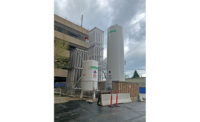Hundreds of components of Victorian-era gasholders have found new life close to their original London home as enclosures for three new, high-end apartment blocks. Erecting the three 35-meter-tall conjoined telescopic tank guide frames was tricky, but no more tricky than restoring the 150-year-old ironwork or reverse-engineering the disassembled structures.
Built and enlarged between 1864 and 1880, the landmark structures were dismantled in 2001 to make way for railroad expansion. They are now revived around three of the many new buildings in the 743,000-sq-m development covering a 27-hectare brownfield site.
Wilkinson Eyre Architects, London, designed a drum-shaped apartment block within each guide frame. With the exteriors clad in gray perforated sliding screens, the nearly completed buildings evoke the original gas storage tanks.
With 33.4 m, 43.3 m and 45.7 m diameters, respectively, the guide frames each include 11 to 14 cast-iron columns of up to 13 tonnes in three tiers. Three layers of circumferential wrought-iron lattice girders link the column tops. The three structures are braced together across the cluster’s center.
The ironwork was generally “in pretty good condition,” says Peter Spear, project director with Carillion PLC, Wolverhampton. Site developer Argent King’s Cross Ltd. hired Carillion to plan and manage the ironwork refurbishment a couple of years before signing its design-build contract, of undisclosed value, for the gasholders and 145 apartment units.
As piling began in February 2014, in Barnsley, 285 kilometers away, Shepley Engineers Ltd. started its two-year ironwork refurbishment subcontract, worth several million dollars.
“It was virtually impossible to ascertain the condition till you got the [29 layers of] paint off,” says Trevor Marrs, the specialty contractor’s head of restoration. As the team exposed raw iron, it developed a schedule of work and costs.
Originally, the tubular columns had been made in long sections, bolted together through hidden, internal flanges. The taller bottom columns had two joints, and the rest had only one.
The ironwork survey revealed some “pretty corroded” internal elements, says Colin Davidson, director of Carillion’s design subcontractor Craddy Pitcher Ltd., Bristol. Since most of the internal bolts had been fitted from inside the 60- to 90-centimeter-dia columns—at the time, probably by small boys—the contractor could not replicate the original method to repair them.
So, more than 160 inaccessible joints have been reinforced externally with mild-steel “bands.” These 1.5-cm-thick, 40-cm-tall bands were drilled and tapped to the column wall, typically 2.5 cm thick.
While Shepley repaired the ironwork, Davidson’s team set out to prove that the reassembled frame could again be safely freestanding. Using wind-model tests, the designers proved the stability by demonstrating “that forces in the structure in a qualitative way are no greater than they had been in the past,” Davidson adds.
At the same time, the engineers had to develop setting-out data for the hundreds of disassembled iron pieces. Tape-measuring the columns and laser-scanning more complicated elements, the team generated 3D AutoCAD models, he says. As the later erection showed, “it worked better than we’d hoped,” Davidson adds.
For the site erection team, “one of the challenges of dealing with cast iron is its fragile nature in bending,” says Spear. During vertical placement, crews supported the columns at intervals roughly 2 m on center.
Last year, the erection subcontractor Bourne Steel Ltd., Poole, placed the columns horizontally on pivoting steelwork frames. Tower cranes hoisted the frames vertically into place and then transferred the columns onto their final bases for bolting down.
Carillon faced some reluctance from subcontractors to bid for the erection work, which was perceived as risky, says Spear. Since the iron components could withstand little bending, “breaking a column would have been a disaster,” he added.







Post a comment to this article
Report Abusive Comment